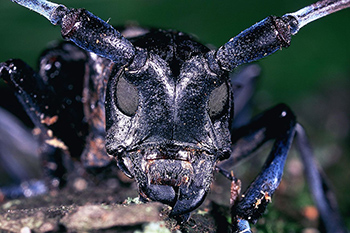Invasive Species Control
As we discussed in Chapter 5, alien species disrupt ecological integrity by competing with, preying upon, and displacing native species, thereby altering community structure and function. They also cost the forestry, agricultural, and fishing sectors several billion dollars each year in lost production (EC 2012b). There are well over a thousand alien species now in Canada (CESCC 2022). A small subset with invasive tendencies is responsible for most of the harm. These are mostly plants and insects. Because control programs are very costly, most efforts are focused on these invasive species (Fig. 7.18).

Several federal government departments are involved in invasive species control at the national level. Their efforts are coordinated through the Invasive Alien Species Strategy for Canada (EC 2004). Provincial governments (especially forestry and agricultural ministries), academic institutions, non-governmental organizations, and individual landowners (especially farmers) also have a significant role in controlling invasive species.
Prevention is widely accepted as the most effective and least expensive means of avoiding or minimizing the risk posed by invasive species (EC 2012b). Border surveillance strategies, including customs inspections, are the first line of defence. These efforts are augmented by regular surveys for high-risk species within the country, often with support from the public. Prevention also involves the use of regulations, best practice guidelines, and public outreach to limit the inadvertent or purposeful movement of invasive species by humans. For example:
- Regulations under the Canada Shipping Act prevent ocean-going vessels that enter the Great Lakes from discharging foreign ballast water (GOC 2011a)
- Public education programs in various jurisdictions aim to prevent the spread of invasive species via fishing boats and the transportation of firewood
- Guidelines for reclamation projects and erosion control now prescribe the use of weed-free native species in place of non-native agronomic species
When invasive species are detected, potential responses include eradication, control, and doing nothing. Eradication efforts are typically undertaken when there is a reasonable prospect of success and the cost of action outweighs the cost of inaction. In practice, such cost-benefit analyses usually focus on economic costs rather than ecological costs. For invasive plants, there is a marked decline in success once the infested area increases beyond one hectare (Rejmanek and Pitcairn 2002). Eradication is usually impractical for infestations larger than 1,000 ha. The implication is that the use of eradication as a management tool depends on early detection and rapid response.
If eradication is not possible, then control measures may be undertaken to maintain invasive populations at levels low enough to be tolerable. The decision to institute control programs again hinges mainly on the cost of action (in this case ongoing cost) relative to the cost of inaction. Control programs can be effective but tend to be expensive. For example, the Sea Lamprey Control Program, initiated in 1955, has reduced sea lamprey populations by 90% (EC 2012b). However, the cost of the program is over $21 million per year, shared by Canada and the US. High cost is why control programs are limited to only the most invasive and damaging alien species.
Eradication and control programs employ three main treatment modalities to eliminate target species: mechanical, chemical, and biological (Simberloff et al. 2013). Mechanical approaches are mostly used for plants and include hand-pulling and mowing prior to seed production. This is a safe option that can be used for small infestations of some species, but it is very labour intensive. Chemical control, involving herbicides and pesticides, is generally more effective and can be used to treat larger areas. The trade-off is that chemical agents tend to kill more than just the target species. Chemical control is also expensive when applied to large areas.
Biological control involves the use of living organisms to reduce the reproduction and vigour of an invasive species, dampening its competitive ability. This is a useful approach for large infestations but it also has challenges. Biological control agents are not available for all invasive species and there is a risk of affecting non-target species, potentially irreversibly (Simberloff et al. 2013). For example, the flowerhead weevil, Rhinocyllus conicus, was released as a bio-control agent in several Canadian and US sites in the late 1960s to control the alien musk thistle. The weevil has since expanded from the initial release sites and has subsequently caused seed destruction of some sparsely distributed native thistles, potentially threatening their viability (Louda et al. 1997).

